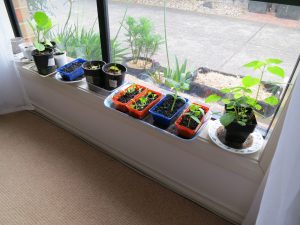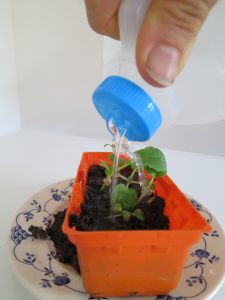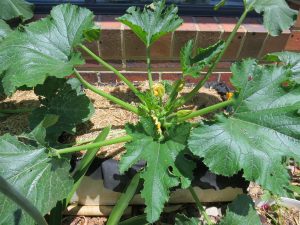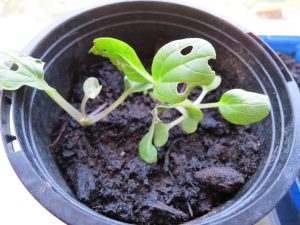Growing your own seedlings is easy, cheap and saves you regular trips to the nursery. Admittedly, you need patience because it takes longer until you can harvest and some seeds may not sprout. Here are some tips that have worked for us:
Preparation:
- Find a sunny spot; this could be a window sill or even somewhere outside if you don’t have a sunny window sill.
- Indoors or protected locations are ideal because of wind, frost and pest protection.
- Buy quality seeds; aim for heirloom seeds because you can collect the seeds from mature plants.
- Initially, you might have to pay more for your seeds (around $5 per sachet) but if you collect your own seeds you’ll won’t have to buy seeds in the future.
- Only collect seeds from plants that have grown strong and have had good yields.
- We make our own potting mix which contains 2/3 of good sandy soil and 1/3 compost (see portable composting) to make sure the soil drains freely.
- If you do buy seedlings or have bought seedlings in the past, collect the punnets they came in as they are great for growing your own seedlings.
- To prevent water making a mess on your window sill, put a plate under your seedling containers or collect containers (e.g. yoghurt, dip or take-away containers) to use as a base.
- A used milk or juice bottle with three small holes drilled in the lid makes for a great seedling watering can so you don’t wash out your seeds (thanks to My Smart Garden for this tip).

Planting:
- Make sure the soil is wet before you put in your seeds.
- Don’t cover your seeds with too much soil.
- The rule of thumb is: add a layer of soil as thick as the actual seed and sometimes they are so tiny that we just gently press them into the soil.
Caring for your seedlings:
- Water in the morning but check in the late afternoon or evening, especially after a warm day as you might have to water your seedlings again.
- If you are away for a few days just move your seedlings out of direct sunlight.
- We have found that the soil will stay relatively moist for three days (excluding days above 30 degrees) and seedlings will still grow in indirect sunlight.
- Bring your seedlings in overnight because it may be too cold for the seeds or pests might attack your delicate seedlings.

Transplanting seedlings into the garden:
- Learn to identify when seedlings are ready to be transplanted into the garden (as this varies for different plants).
- As a rule of thumb, most plants in our garden are ready to move if the roots are growing out of the punnet though we let some plants like zucchini grow bigger so they are more pest resistant when transplanted.
- Choose a good day to move them; if it’s going to be a hot day or a day with torrential rain just wait for a weather change to avoid putting your seedlings under unnecessary stress.
- Some plants may need an adjustment period so if they’ve only been inside, move them outside for a few days during the day before transplanting and keep them inside overnight.
- Before you move your seedling out of its punnet, water it well and let the punnet sit for ten minutes
- Remove your seedling carefully out of the container to avoid root breakage.
- After planting the seedling in its final location, give it a good splash of water and cover the soil with mulch to avoid water evaporation.
- If you have more than one seedling in a punnet you can fill a bucket with a bit of water and carefully wash the soil away and then you can slowly separate the roots to avoid root breakage.
- If you think your seedling is ready to move outside but the weather is not quite right just move it into a bigger container so it can keep on growing.

- Once your seedlings are outside just keep an eye out over the next couple of weeks to see how they settle in.
- Even if you use a wicking bed or bucket you might have to manually water your seedlings for up to a week because seedling roots are still very short and cannot easily draw water.
- In general, always plant more seeds than you actually need.
- We found that 2/3 of our seedlings were successful.
- If you happen to grow too many you can swap with someone or use it as a (birthday) gift; we have found that our friends and family love receiving them!
Watch out for pests:

- Because seedlings are very delicate, snails, earwigs and other pests love to munch on them.
- For more mature plants, low levels of pests are generally not a problem (and give the birds something to feed on) but the same pests, especially in larger numbers can decimate vulnerable seedlings in a single night.
- Growing seedlings indoors has a big advantage as pests can’t get to them.
- When transplanting new seedlings, observe your garden once it’s dark to find and remove snails and earwigs that could be a threat to your newly transplanted seedlings.
- Green and leafy plants that are tender (like lettuce) are vulnerable to cabbage butterfly attack, though this can be prevented by putting netting over the plants to prevent the butterflies from laying eggs in your greens.
- We have found that growing some plants larger as seedlings (like zucchini or cucumbers) makes them less attractive to snails and earwigs.
- Some pest issues are seasonal, for example, when we planted lettuce seedlings in winter, there were minimal pest issues compared to planting in spring and summer.
If your seedlings aren’t sprouting or growing well, possible problems may include:
- Old or expired seeds.
- The wrong climate for your chosen seeds.
- Your soil is too dry.
- The soil is not warm enough yet (e.g. eggplants need the soil to be warm to germinate).
Try these easy to grow seedlings:
- Salad greens (like lettuce, silverbeet or kale)
- Zucchini
- Lebanese cucumbers
- Radishes
- Tomatoes
- Eggplants
Growing your own seedlings is a must for any gardener who is serious about producing some or most of their own produce. As a renter, you don’t need a green house to grow lots of seedlings; one or more sunny window sills work perfectly fine and will add some beautiful greenery to your indoor spaces.